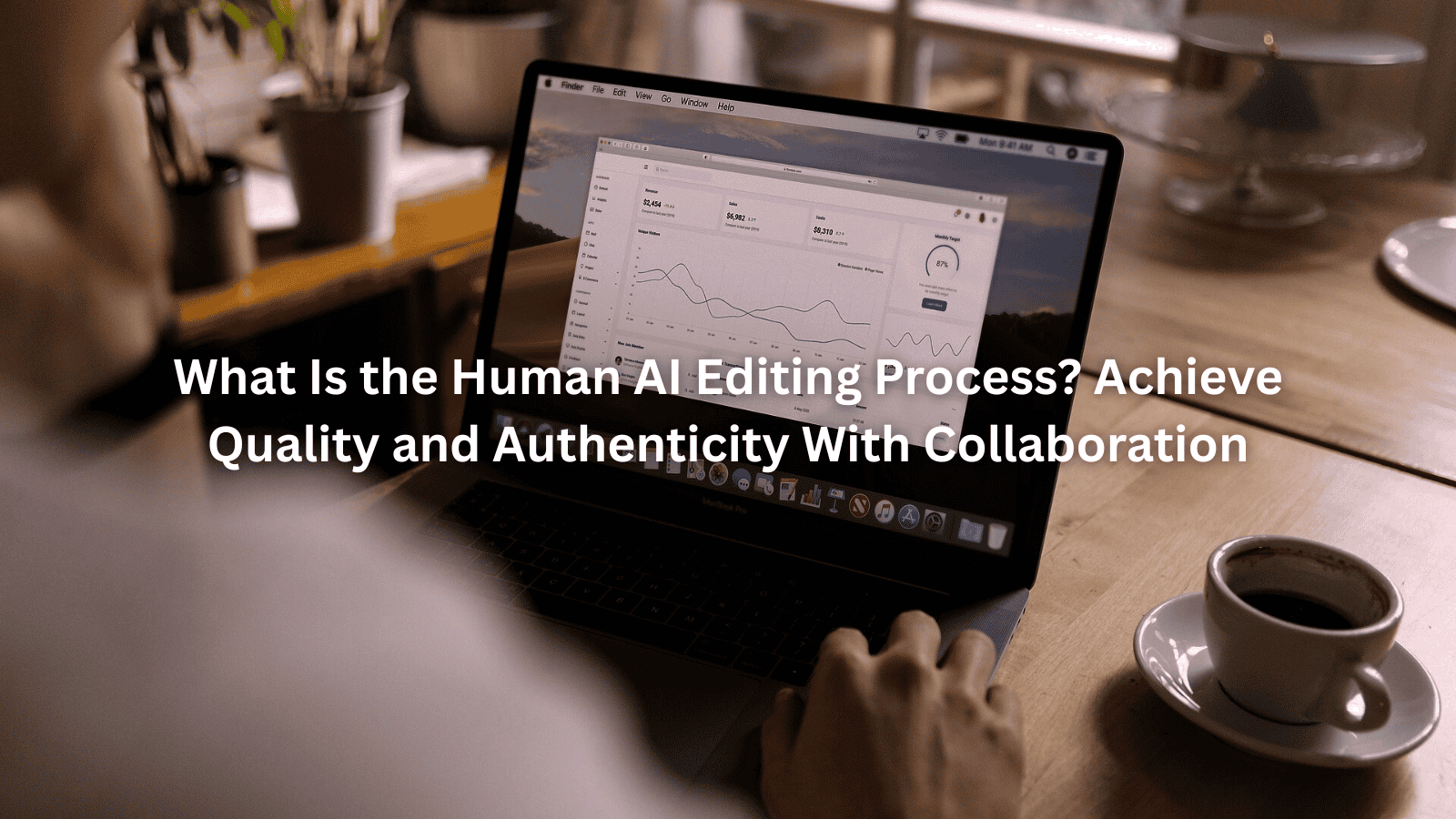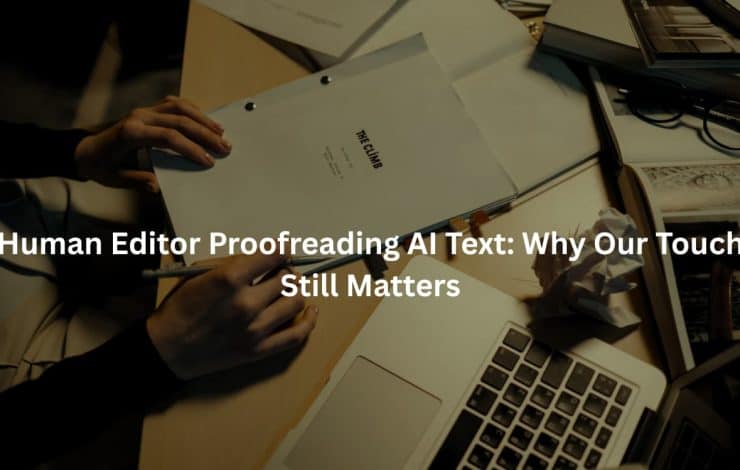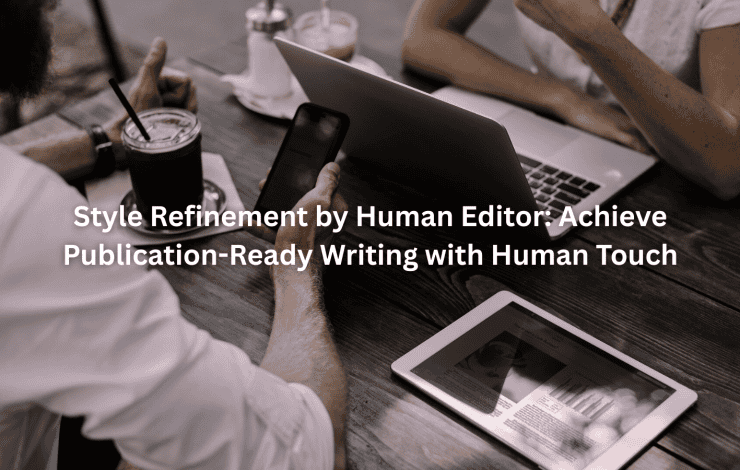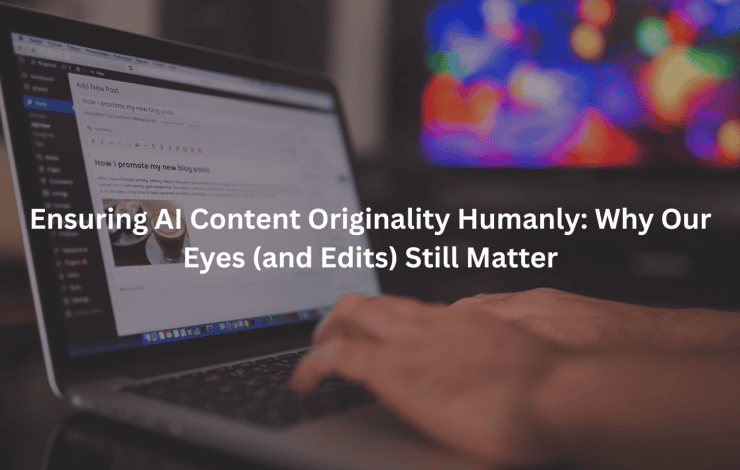Use AI to clean up your draft, then have a human editor bring out the heart. That’s the simplest way to frame how the human AI editing process works. AI speeds up grammar correction and structure, while people inject context, fact-checking, and a voice that feels real. The result is content that’s accurate, engaging, and still unmistakably human.
Key Takeaways
- AI quickly tackles grammar, style, and repetitive tasks, letting humans focus on nuance and narrative.
- Human editors ensure accuracy, emotional resonance, and context, things AI often gets wrong.
- This collaborative process boosts both content quality and efficiency, especially when using services like Jet Digital Pro.
Understanding the Human AI Editing Process
There’s always that moment after our AI returns a first edit. The text is clean, every comma seems right, transitions look smooth, but if you read it out loud, you start to notice something’s off. Maybe it’s how the sentences line up, too mechanical, too perfect, not how anyone really talks. At Jet Digital Pro, we see this every day. The piece is technically correct, passes every grammar check, but it lacks voice. It’s like reading a manual when you were promised a story. That’s exactly where the human AI editing process fits in.
This process isn’t just about fixing typos or running a spell-check. It’s a true collaboration between machine learning editing and plain old human insight. We like to think of the AI as our reliable, slightly obsessive assistant. It works fastest on the things that sap a human’s energy, repetitive spelling fixes, grammar mistakes, flagging sentences that drag on, or scanning for accidental plagiarism. It can even tidy up style and suggest a tighter structure. But that’s just the start.
After AI takes its first swing, we step in. Our role as human editors is to bring the draft to life. We’re looking for narrative improvement, context awareness, and that hard-to-pin-down thing called “emotional resonance.” There’s a balance here. We want the speed and consistency AI gives us, but we’re not willing to lose what makes content feel human. Every sentence should sound like it belongs to someone, not to a machine.
We’ve applied this process everywhere, from digital publishing and academic editing to producing high-volume marketing blogs for agencies. At Jet Digital Pro, editorial oversight is part of our DNA. We use AI-assisted editing for what it’s good at, volume, structure, and technical fixes. Then we rely on our own creativity and critical thinking to polish the work. That’s how we achieve humanized AI content. Not just content that ranks, but content that resonates with real people.
Let’s break down what this looks like in our daily workflow:
- AI takes the first pass: grammar correction, sentence restructuring, plagiarism detection, style refinement, and even a stab at tone adjustment.
- Human editors review: for context, voice, accuracy, and narrative flow.
- Iterative collaboration: sometimes, we go back and forth, tweaking AI prompts and refining the output until it feels right.
The process isn’t linear. It’s a conversation between what the AI suggests and what our editors know works.
We’ve learned that even the best AI can’t catch everything. It’ll miss cultural nuance, it’ll flatten out humor, and sometimes it’ll even add facts that aren’t true. That’s why our workflow always includes a human in the loop, especially for sensitive or high-stakes content.
Initial AI Editing Stage
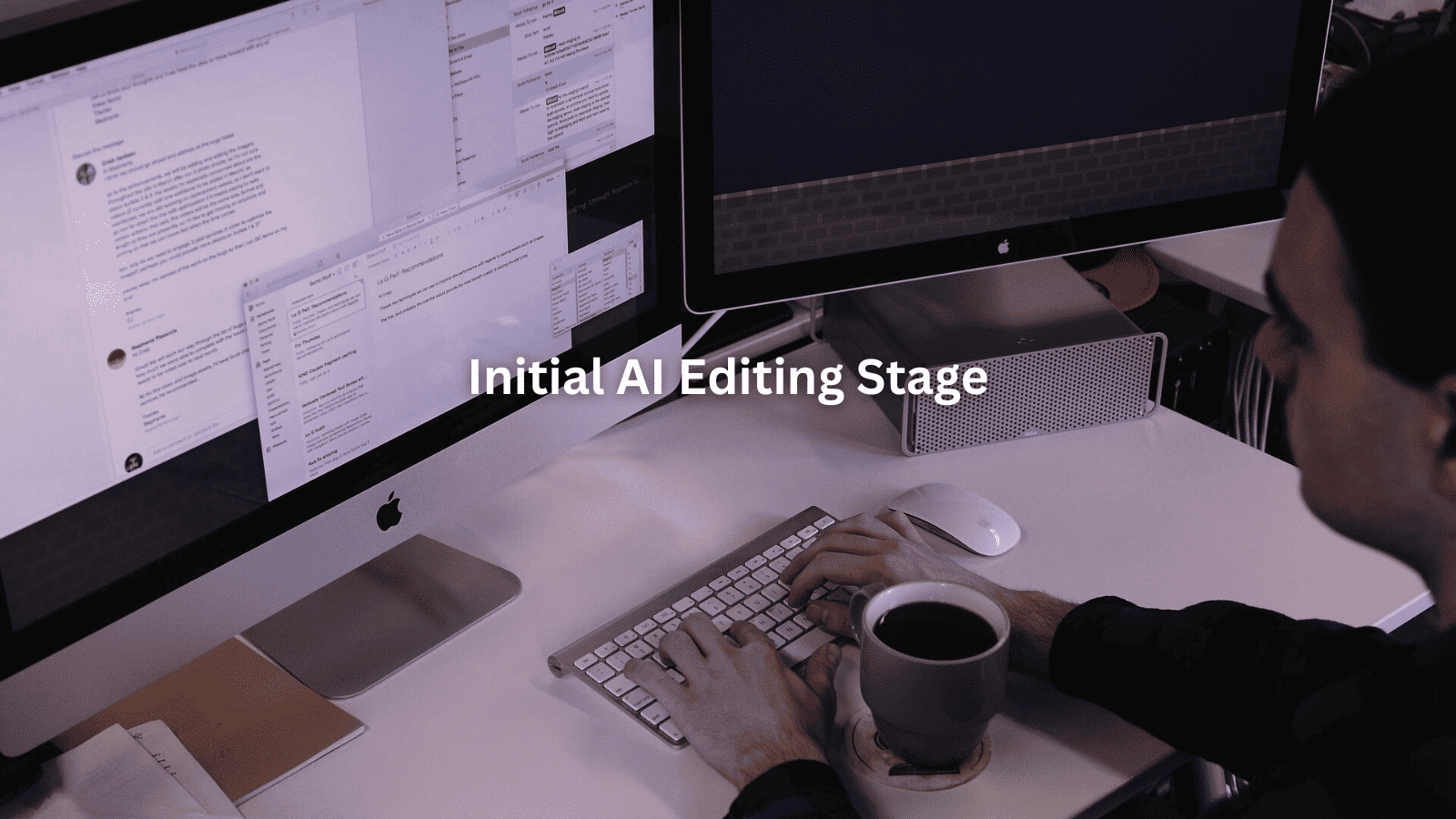
AI’s first go at editing feels a bit like watching a fast-forwarded movie of your own writing. The machine doesn’t get tired, and it doesn’t daydream. We use it for what it does best, sweeping through thousands of words, correcting spelling and grammar, and identifying patterns that would take a human hours to spot.
Here’s what our AI typically handles at Jet Digital Pro:
- Grammar, spelling, and punctuation correction: The basics, but at scale. No more missing commas or rogue apostrophes.
- Repetitive phrase removal: AI can flag overused words or phrases, a task that would make most editors cross-eyed after a while.
- Style refinement: The machine can suggest a more active voice, shorter sentences, or a different structure to improve readability.
- Plagiarism detection: It runs every draft through its filters, making sure nothing gets reused by accident.
- Metadata generation: Titles, descriptions, and even keyword tags can be suggested.
- Tagging and sorting: AI helps us organize content for different platforms without missing a beat.
We’ve found that AI is astonishingly good at volume. We often run entire content calendars, thousands of words at a time, through our system before a human editor even looks at the piece. Tagging, topic modeling, and basic copy editing are all done in minutes, not days.
But cracks show up quickly. AI can correct grammar, sure, but what about context? We’ve seen it replace specific industry terms with more generic ones, losing the nuance our clients need. Sometimes, it’ll awkwardly swap out keywords in an attempt to optimize for search engines, but the sentence loses its natural flow. [ 1 ]
“AI hallucination” is another issue. The machine sometimes invents facts, statistics, or even quotes that sound plausible but don’t exist. These mistakes are subtle, and if you’re not paying attention, they’ll slip through into the final draft. We’ve caught AI claiming a study exists when it doesn’t or attributing a quote to the wrong person. That’s a risk we’re not willing to take.
There’s also the matter of emotional resonance. Even the best AI struggles to understand humor, irony, or sarcasm. It can’t read between the lines, and it doesn’t know when to break a rule for effect. These are the moments when our editors step in, and the difference is night and day.
At Jet Digital Pro, we’ve integrated AI tools directly into our editorial workflow. But we never let the machine have the final say. There’s always a second stage, a human review that sees the piece as a whole, not just a list of fixes.
Human Review and Refinement Stage
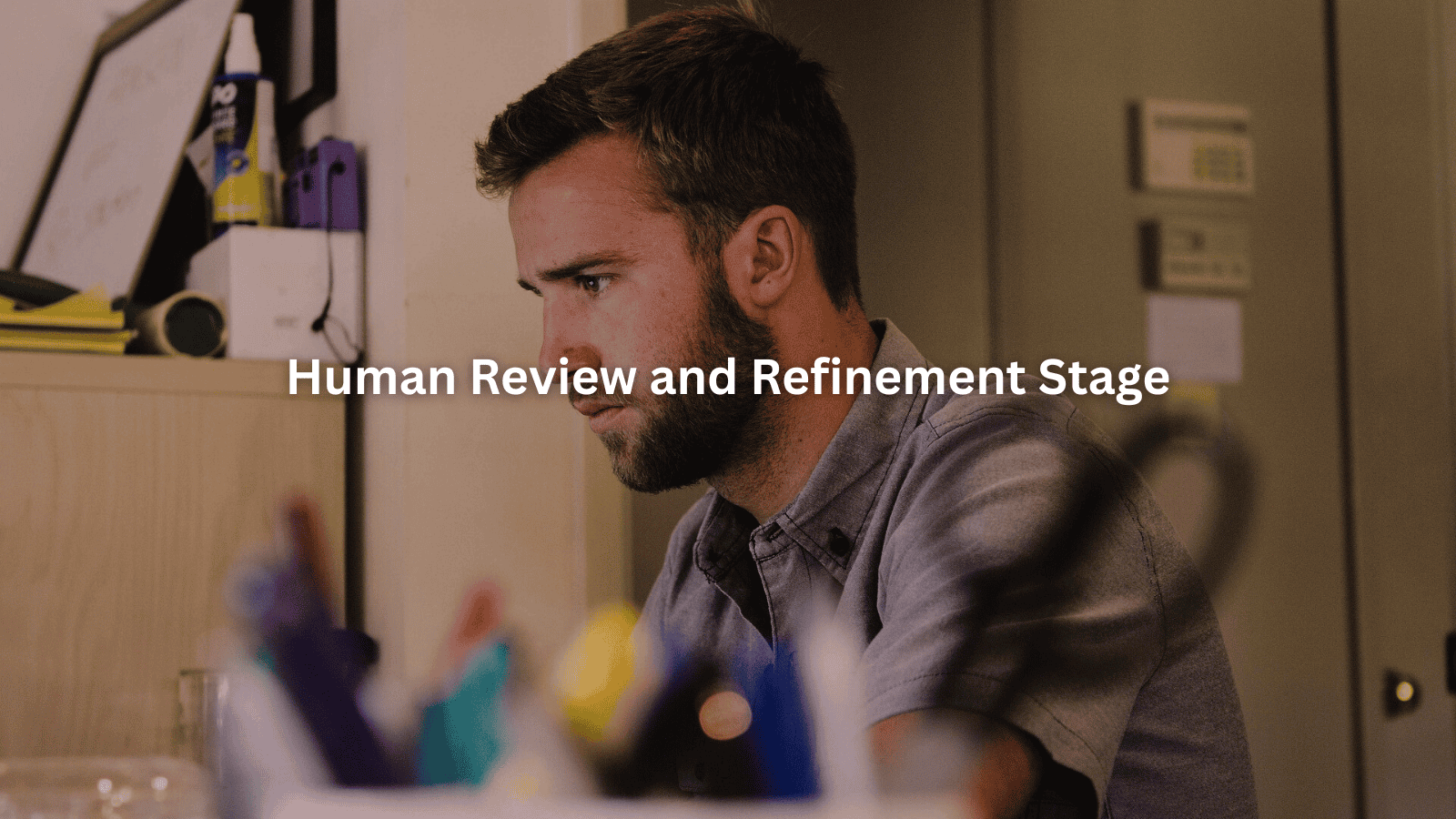
This is where the magic happens. Once AI has done its job, our editors step in to do what only humans can. We’re not just looking for typos or double spaces, though we catch those too. We’re looking for voice, intent, and clarity. We want the piece to sound like it was written by someone with a point of view, not by a machine trained on billions of words. [ 2 ]
Here’s what our editors focus on at Jet Digital Pro:
- Fact-checking and accuracy verification: We check every claim, every statistic, and every reference. AI can’t always tell what’s real and what’s invented.
- Tone adjustment and voice consistency: We make sure the piece matches the client’s brand and sounds like it was written for the intended audience.
- Contextual understanding: We catch subtle shifts in meaning when AI changes a word or restructures a sentence.
- Narrative improvement: We look at the big picture, ensuring the story flows and keeps the reader engaged.
- Adding emotional resonance: We adjust language, add anecdotes, or tweak jokes to make the content feel alive.
- Cultural nuance: We edit for regional differences, current events, and sensitive topics that AI might miss.
- Sentence restructuring and transition smoothing: We fix awkward phrasing and make sure every paragraph leads naturally to the next.
- Readability enhancement and style guide compliance: We use our judgment to make sure the content is clear, concise, and follows the client’s rules.
Sometimes, the process is iterative. We’ll provide comments, suggestions, and examples for future AI prompt customization. If we notice the AI struggles with a certain topic or writing style, we adjust the prompts or retrain the model with fresh examples.
The human touch is what sets our editing apart. We inject real experience, critical thinking, and creativity. We’re not afraid to rewrite whole sections if it means the final piece will resonate with readers. At Jet Digital Pro, we pride ourselves on producing content that stands up to both Google’s algorithms and human scrutiny.
We’ve seen firsthand how this approach pays off. Our content consistently bypasses AI detection tools, ranks well in search, and, most importantly, connects with readers. For agencies looking for white-label SEO content solutions, this process is scalable and customizable, whether you need blog writing, link building, or on-page SEO. We believe that great content comes from the right blend of machine efficiency and human insight, and we wouldn’t do it any other way.
Models of Human-AI Collaboration
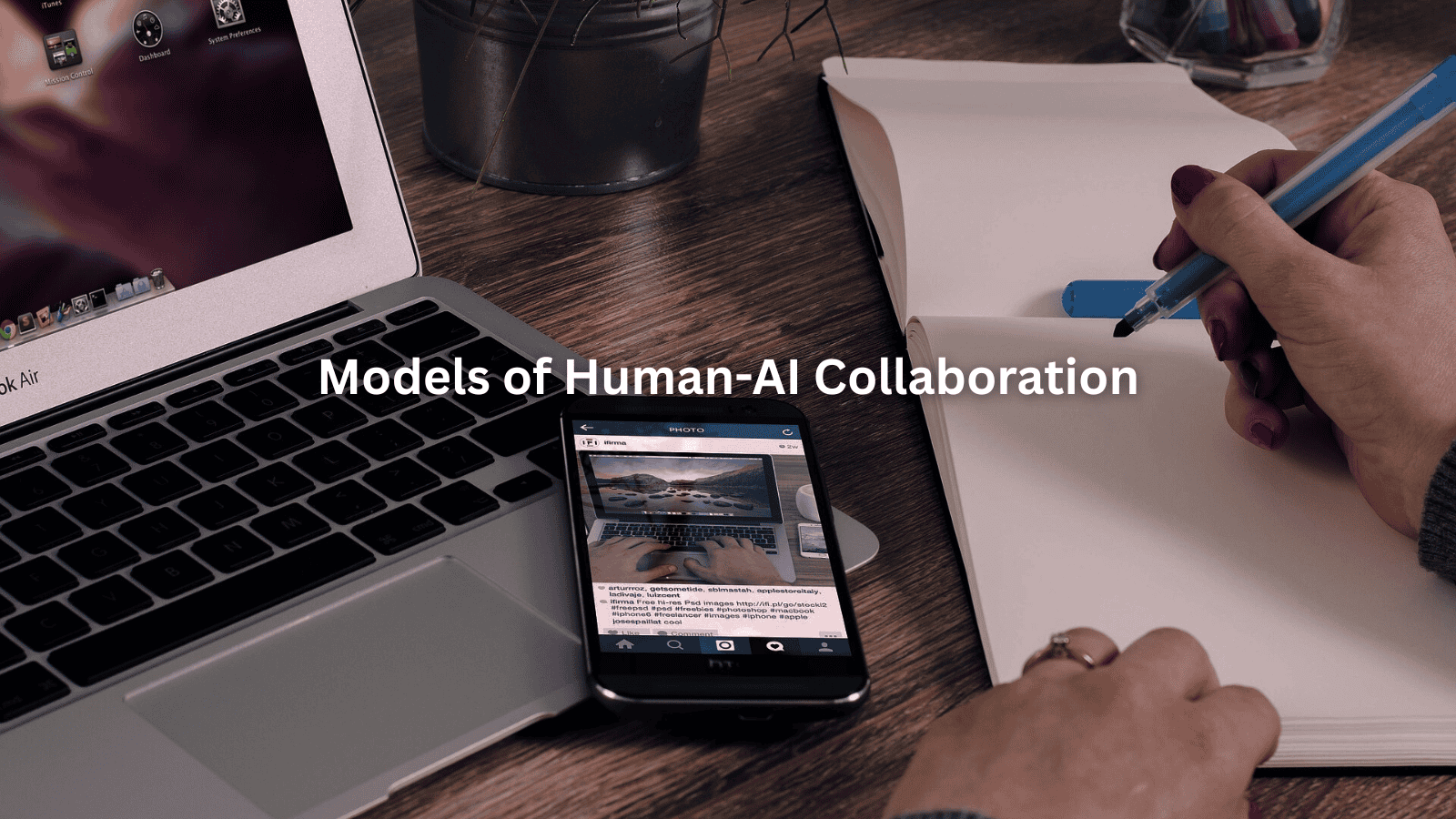
Are You a Digital Agency?
White Label SEO Content Services for Agencies
Scalable, customizable, and results-driven content solutions for your clients.
We’ve experimented with different models. The Human-in-the-Loop (HITL) approach means we’re always involved. Editors review every draft before it goes live, ensuring high accuracy, editorial balance, and compliance with client style guides. This is our go-to for sensitive projects, like medical or financial copy.
Then there’s the Human-on-the-Loop model. Here, we let AI do more of the heavy lifting, checking in only when the machine gets stuck or when the stakes are lower. It works well for speed, think mass content production or SEO blog writing.
Choosing the right model is about weighing efficiency against content sensitivity. High-stakes domains demand more human oversight. Lower-risk projects can afford to prioritize speed. Jet Digital Pro adapts our process to fit these needs, always keeping editorial standards at the core.
We’ve learned that AI and humans aren’t rivals, they’re partners. The best results come from a deliberate blend of machine efficiency and human insight. Here’s what we tell digital agencies and content creators:
- Use AI for what it does best, bulk editing, style refinement, and basic SEO optimization.
- Always reserve time for human review, especially for fact-checking, narrative flow, and emotional resonance.
- Find the right blend of human-in-the-loop or on-the-loop for your project’s needs.
At Jet Digital Pro, we keep human editors at the center of our process, ensuring every piece of content is trustworthy, authentic, and ready for the spotlight. If you want content that stands up to Google’s scrutiny and still feels real, combine the best of both worlds. That’s how we do it, and it’s how you should too.
FAQ
How do editors handle AI-generated mistakes that aren’t obvious, like subtle changes in meaning?
Editors often spot subtle errors by reading for intent and context, not just grammar. If an AI changes a word or phrase that shifts the meaning, our team compares the revised draft to the original. We ask ourselves if the facts, tone, or implications have changed. If something feels off, we dig in, sometimes checking outside sources or asking the writer for clarification.
Can the human AI editing process adapt to specific style guides or client preferences?
Need a Strategic SEO Content Partner?
Let’s craft SEO content that ranks, converts, and grows your brand.
Talk to UsAbsolutely. We train both our AI tools and our editors to follow each client’s guidelines. AI can be prompted with custom rules, and our editors double-check for style guide compliance before anything goes live. If a client has unique preferences, we keep a reference and review every piece with those details in mind, making sure nothing gets missed.
What does “AI hallucination” mean and how do human editors catch it?
AI hallucination happens when a machine invents facts or details that aren’t true. It’s sneaky because the sentences sound natural. Our editors notice hallucinations by fact-checking claims, looking up statistics, and using their judgment. If something seems unlikely or too perfect, we verify it. We also use past experience to spot patterns where AI tends to get things wrong.
How can human editors make AI-edited content sound less robotic and more engaging?
Human editors read the text aloud or imagine a real person saying it. We look for stiff phrases, repeated sentence structures, or language that doesn’t match the intended audience. Then we rewrite sections, add examples, and sometimes insert a bit of humor or storytelling. These small touches help the final draft feel natural and keep readers interested.
What are the risks if a team relies only on AI for editing without human oversight?
Teams that skip human review risk publishing content with errors, awkward phrasing, or even factual mistakes. AI can miss cultural nuances, make inappropriate word choices, or fail to capture a brand’s voice. Over time, this can hurt both credibility and engagement. We’ve found that a human touch is essential for trust, especially with sensitive or high-stakes topics.
Conclusion
Mixing AI and human editing isn’t just smart, it’s necessary. Machines bring speed and scale, but real editors add context, trust, and a voice readers connect with. At Jet Digital Pro, we blend AI efficiency with an 11-step human editing process to deliver high-quality, Google-resilient content that feels genuine and ranks well. If your agency wants content that stands out and drives results, keep humans in the loop. Contact us today to get started.
References
- https://en.tempo.co/read/2004217/wikipedia-ai-will-not-replace-human-volunteers
- https://slator.com/does-word-level-quality-estimation-really-improve-ai-translation-post-editing/
Related Articles
- https://jetdigitalpro.com/how-human-ai-content-editors-work/
- https://jetdigitalpro.com/ensuring-ai-content-originality-humanly/
- https://jetdigitalpro.com/style-refinement-by-human-editor/
P.S – Whenever you’re ready,
we’re here to help elevate your SEO content.
Partner with us for strategic, scalable content that drives real organic growth.
Contact Us Now
